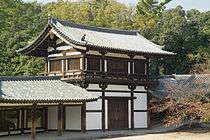Kyōzō

Kyōzō (経蔵) in Japanese Buddhist architecture is a repository for sūtras and chronicles of the temple history. It is also called kyōko (経庫), kyō-dō (経堂), or zōden (蔵殿).[1] In ancient times the kyōzō was placed opposite the belfry on the east-west axis of the temple. The earliest extant kyōzō is at Hōryū-ji, and it is a two-storied structure.[1] An example of one-storied kyōzō is at Tōshōdai-ji in Nara. A kyōzō's usual size is 3 x 3 ken. Mahayana Buddhism is one of the sects within Buddhism and one way to create written sutras or sermons. Unlike Judeo-Christian religions, including Islam, Buddhism does not revere those written words, or sutras, as the Christians, the Muslims, or the Jews do. The title of this article is Circumambulatory Reading: Revolving Sutra Libraries and Buddhist Scrolls and circumambulation, or walking around while taking it in, is prevalent in Buddhism because the wheel is the international sign of Buddhism. Revolving sutra libraries were invented in China and were later brought to Japan. Revolving sutra libraries were created for the same reason, and if a temple visitor revolved that library, they would amass the same esteem as if they had read the entire sutra (Eubanks, 2010).[2]
All storage buildings are equipped with shelving to store the containers that hold the rolled sūtras. Some temples have circular revolving shelves for sūtra storage: a central pillar revolves, like a vertical axle, and octahedral tubes are attached to it. A revolving sūtra storage case is called rinzō (輪蔵, wheel repository).[1] Revolving shelves are convenient because they allow priests and monks to select the needed sūtra quickly. Eventually, in some kyōzō the faithful were permitted to push the shelves around the pillar while praying — it was believed that they could receive religious edification without actually reading the sūtras.[1]
Some scripture houses are National Treasures of Japan:
- The kyōzō of Tōshōdai-ji
- The kyōzō of Hōryū-ji
- The kyōzō of Ankoku-ji
Gallery
 The kyōzō at Hōryū-ji, 8th century |
 The kyōzō at Tōshōdai-ji, 8th century |
 Revolving shelves at Zenkō-ji |
 Rinzō at Hase-dera |
References
- 1 2 3 4 Parent, Mary Neighbour. Japanese Architecture and Art Net Users System. Kyouzou, retrieved on June 14, 2011
- ↑ Eubanks, Chartlotte (2010). "Circumambulatory reading: revolving sutra libraries and buddhist scrolls". Book History. 13: 1–24. doi:10.153/bh.2010.0020.
| Wikimedia Commons has media related to Kyōzō. |